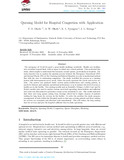Queuing Model for Hospital Congestion with Application
Date
2023-11-25Author
Okoth, F. O.
Okoth, A. W.
Nyongesa, K. L.
Sirengo, J. L.
Metadata
Show full item recordAbstract
The emergence of Covid-19 posed a great health challenge worldwide. Health care facilitieswere stretched beyond limit, with no space to admit new critical patients. This motivated thisstudy, which sought to understand the dynamics around queues, particularly in hospitals. Themain objective was to analyze the queuing process between the Emergency Department (ED)and Internal Wards (IW) at Moi Teaching and Referral Hospital, in order to understand patientflow with the view to minimizing congestion. The study modelled the process as a queuingsystem with heterogeneous server pools, where the pools represent the wards and servers arebeds. The system was analysed under various queue-architectures and routing policies, insearch for fairness and optimum operational performance so as to enhance the level of access tohealth care in the facility. The existing models such as Kendall’s, Erlang’s, Little’s Law and DeBruin’s models were used to analyze various ward/unit operating characteristics and sufficientbed count was determined to guarantee certain access standards to care. The results indicatedthat there were long queues arising from blockage which led to higher chances of patientswaiting for long hours for services in the facility. To solve the problem the study proposesreassignment of beds within the Hospital wards so that any arriving patient and those waitingfor services are examined and allocated beds immediately. This will reduce the long waitingtime for services and give the hospital sufficient time in daily operations.
URI
https://doi.org/10.5281/zenodo.10202664http://ijmso.unilag.edu.ng/article/view/1982/1547
http://ir-library.mmust.ac.ke:8080/xmlui/handle/123456789/2426
Collections
- Gold Collection [1026]

